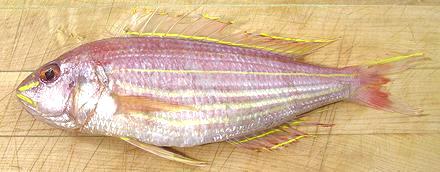Golden Thread
 [Golden threadfin bream; Bisugo (Philippine); Pla Sai Dang (Thai);
Nemipterus virgatus]
[Golden threadfin bream; Bisugo (Philippine); Pla Sai Dang (Thai);
Nemipterus virgatus]
This small West Pacific fish is commercially important in the East and
South China Seas and is common in Asian markets in California. It is
aso sold as Daing (dried fish)
in Philippine markets. While these fish can grow to a little over 13
inches, the photo specimen, caught wild in Vietnam, was 10-1/2 inches
long and weighing 8 ounces. The name comes from a yellow thread
extending an inch or so from the top tip of the tail but this will
be missing by time the fish is in the market, due to handling while
frozen.
This fish varies in color from almost all silver with light iridescent
color to the rather gaudy paint job of the photo specimen. All I have seen
do have the yellow markings on the fins and the top tip of the tail is
yellow.
More on Threadfin Bream.
Golden Thread flesh is lightly colored with enough flavor to be
interesting but not notably strong. There is, however, a dark layer right
under the skin with a stronger taste. The flesh is very tender raw but
firms up when cooked. It flakes apart easily on the plate.
Cooked whole or pan dressed this fish is a bit of a problem on the
plate because the rib cage comes completely apart, so all ribs and
centerline pin bones have to be dealt with individually. The fins do pull
away fairly neatly.
If baking or steaming whole or pan dressed, you want to make a couple
of diagonal cuts half way through the flesh because otherwise the fish
tends to break unattractively.
In China this fish is often used to make fish balls. In the
Philippines this fish is often dusted with salted flour, pan fried and
served with lemon and bagoong alamang (shrimp paste).
Scales:
The scales are surprisingly large but scrape off
easily without a lot of flying about. Because they are large, very thin
and almost totally transparent they do stick to everything and are not the
easiest to clean up.
Cleaning
Most of the innards seem to be up in the head
and not easy to get at. The gills are very far forward and pull rather
hard. For these reasons I recommend immediately removing the head unless
you really want a head-on fish. Even removed from the fish the head is
not easy to clean out unless you cut under the chin and remove the collar
for better access. The body cavity extends somewhat beyond the vent.
Fillet:
This is an easy fish to fillet with an easy to
follow bone structure. Cut down from the top to the backbone, then over the
backbone at the tail until you get to the rib cage. Cut the ribs off with
kitchen shears and pull them from the fillet - they pull very easily. There
are a few significant centerline pin bones that need to be located and pulled
straight forward as they do not soften in cooking.
Skin:
The skin has no strong or "off" flavor. It has
moderate shrink but soon releases from the fillet. Skin-on fillets can be
pan fried successfully lightly dusted with rice flour. When turned skin
side down the fillet will curl a bit but within a few seconds can be
patted flat with your turner. This is a rather difficult fish to skin
because the skin is so thin and delicate, it tends to break. If it
breaks while skinning from the tail end, turn the fillet around and
try skinning from the point at the top front.
Stock:
The heads (well cleaned and split), bones and
fins, simmered slowly for about 40 minutes make a light flavored, nearly
clear and serviceable stock with very little oil. Remove what oil there
is using your gravy separator.
sf_goldtz 110423 - www.clovegarden.com
©Andrew Grygus - agryg@clovegarden.com - Photos on this
page not otherwise credited are © cg1 -
Linking to and non-commercial use of this page permitted
 [Golden threadfin bream; Bisugo (Philippine); Pla Sai Dang (Thai);
Nemipterus virgatus]
[Golden threadfin bream; Bisugo (Philippine); Pla Sai Dang (Thai);
Nemipterus virgatus]